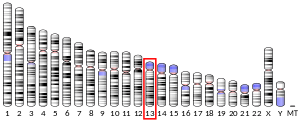TNFRSF19
Tumor necrosis factor receptor superfamily, member 19, also known as TNFRSF19 and TROY is a human gene.[5]
The protein encoded by this gene is a member of the TNF-receptor superfamily. This receptor is highly expressed during embryonic development. It has been shown to interact with TRAF family members, and to activate JNK signaling pathway when overexpressed in cells. This receptor is capable of inducing apoptosis by a caspase-independent mechanism, and it is thought to play an essential role in embryonic development. Alternatively, spliced transcript variants encoding distinct isoforms have been described.[5]
References
Further reading
- Robertson NG, Khetarpal U, Gutiérrez-Espeleta GA, et al. (1995). "Isolation of novel and known genes from a human fetal cochlear cDNA library using subtractive hybridization and differential screening". Genomics. 23 (1): 42–50. doi:10.1006/geno.1994.1457. PMID 7829101.
- Kojima T, Morikawa Y, Copeland NG, et al. (2000). "TROY, a newly identified member of the tumor necrosis factor receptor superfamily, exhibits a homology with Edar and is expressed in embryonic skin and hair follicles". J. Biol. Chem. 275 (27): 20742–7. doi:10.1074/jbc.M002691200. PMID 10764796.
- Eby MT, Jasmin A, Kumar A, et al. (2000). "TAJ, a novel member of the tumor necrosis factor receptor family, activates the c-Jun N-terminal kinase pathway and mediates caspase-independent cell death". J. Biol. Chem. 275 (20): 15336–42. doi:10.1074/jbc.275.20.15336. PMID 10809768.
- Naito A, Yoshida H, Nishioka E, et al. (2002). "TRAF6-deficient mice display hypohidrotic ectodermal dysplasia". Proc. Natl. Acad. Sci. U.S.A. 99 (13): 8766–71. doi:10.1073/pnas.132636999. PMC 124373. PMID 12060722.
- Strausberg RL, Feingold EA, Grouse LH, et al. (2003). "Generation and initial analysis of more than 15,000 full-length human and mouse cDNA sequences". Proc. Natl. Acad. Sci. U.S.A. 99 (26): 16899–903. doi:10.1073/pnas.242603899. PMC 139241. PMID 12477932.
- Clark HF, Gurney AL, Abaya E, et al. (2003). "The secreted protein discovery initiative (SPDI), a large-scale effort to identify novel human secreted and transmembrane proteins: a bioinformatics assessment". Genome Res. 13 (10): 2265–70. doi:10.1101/gr.1293003. PMC 403697. PMID 12975309.
- Zhang Z, Henzel WJ (2005). "Signal peptide prediction based on analysis of experimentally verified cleavage sites". Protein Sci. 13 (10): 2819–24. doi:10.1110/ps.04682504. PMC 2286551. PMID 15340161.
- Gerhard DS, Wagner L, Feingold EA, et al. (2004). "The status, quality, and expansion of the NIH full-length cDNA project: the Mammalian Gene Collection (MGC)". Genome Res. 14 (10B): 2121–7. doi:10.1101/gr.2596504. PMC 528928. PMID 15489334.
- Park JB, Yiu G, Kaneko S, et al. (2005). "A TNF receptor family member, TROY, is a coreceptor with Nogo receptor in mediating the inhibitory activity of myelin inhibitors". Neuron. 45 (3): 345–51. doi:10.1016/j.neuron.2004.12.040. PMID 15694321.
- Shao Z, Browning JL, Lee X, et al. (2005). "TAJ/TROY, an orphan TNF receptor family member, binds Nogo-66 receptor 1 and regulates axonal regeneration". Neuron. 45 (3): 353–9. doi:10.1016/j.neuron.2004.12.050. PMID 15694322.
- Spanjaard RA, Whren KM, Graves C, Bhawan J (2007). "Tumor necrosis factor receptor superfamily member TROY is a novel melanoma biomarker and potential therapeutic target". Int. J. Cancer. 120 (6): 1304–10. doi:10.1002/ijc.22367. PMID 17187358.
- Satoh J, Tabunoki H, Yamamura T, et al. (2007). "TROY and LINGO-1 expression in astrocytes and macrophages/microglia in multiple sclerosis lesions". Neuropathol. Appl. Neurobiol. 33 (1): 99–107. doi:10.1111/j.1365-2990.2006.00787.x. PMID 17239012.
This article incorporates text from the United States National Library of Medicine, which is in the public domain.
This article is issued from
Wikipedia.
The text is licensed under Creative Commons - Attribution - Sharealike.
Additional terms may apply for the media files.



